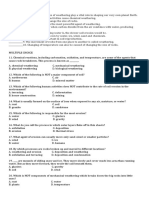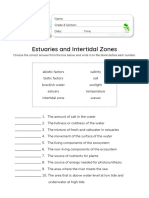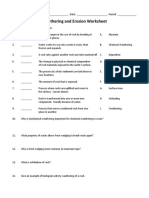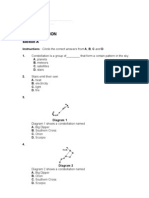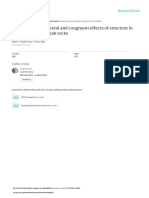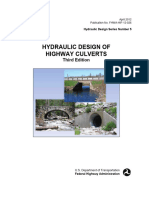Answer Key Grade Six: Weathering and Erosion: Multiple Choice: (4 Points Each)
Answer Key Grade Six: Weathering and Erosion: Multiple Choice: (4 Points Each)
Uploaded by
emmanuel richardCopyright:
Available Formats
Answer Key Grade Six: Weathering and Erosion: Multiple Choice: (4 Points Each)
Answer Key Grade Six: Weathering and Erosion: Multiple Choice: (4 Points Each)
Uploaded by
emmanuel richardOriginal Title
Copyright
Available Formats
Share this document
Did you find this document useful?
Is this content inappropriate?
Copyright:
Available Formats
Answer Key Grade Six: Weathering and Erosion: Multiple Choice: (4 Points Each)
Answer Key Grade Six: Weathering and Erosion: Multiple Choice: (4 Points Each)
Uploaded by
emmanuel richardCopyright:
Available Formats
ANSWER
KEY
Grade
Six:
Weathering
and
Erosion
Post
Test
Multiple
Choice:
(4
points
each)
Directions:
Please
circle
the
best
answer.
1. The
movement
of
rock
particles
by
ice,
wind,
water,
or
gravity
is
called
________B___________.
a. weathering
b. erosion
c. deposition
d. sedimentary
2. The
actions
of
animals
most
commonly
can
cause
the
type
of
weathering
known
as
______A_______.
a. mechanical
weathering
b. chemical
weathering
c. general
weathering
d. electrical
weathering
3. After
chemical
weathering,
what
happens
to
the
chemical
makeup
of
the
weathered
rock?
B
a. The
rock
stays
the
same.
b. The
rock
changes
form.
c. The
rock
gets
larger.
d. The
rock
disappears.
4. In
the
1930’s
an
area
in
the
southern
Plains
states
was
named
the
_______C________
because
the
topsoil
turned
to
dust.
a. Rose
Bowl
b. Super
Bowl
c. Dust
Bowl
d. Water
Bowl
5. The
process
by
which
natural
forces
move
weathered
rock
and
soil
from
one
place
and
deposit
in
another
is
called
_______B_____________.
a. soil
conservation
b. deposition
c. abrasion
d. erosion
6. A
ridge
of
till
located
at
the
farthest
point
reached
by
a
glacier
is
called
a
___________C____________.
a. mountain
b. valley
c. terminal
moraine
d. flood
plain
6.D Post Assessment: Weathering and Erosion 1
❊Science M atters
7. Where a coastline turns and interrupts longshore drift, sand may be deposited in a fingerlike
landform called a __________A______________.
a. spit
b. barrier beach
c. sandbar
d. headland
8. Landslides, mudflows, slumps, like La Conchita, and creeps are all examples of________C_________.
a. mechanical weathering
b. runoff
c. mass movement
d. soil formation
9. The energy that produces ocean waves comes from________C_________.
a. the rise and fall of the tides.
b. rivers flowing into the ocean.
c. wind blowing across the water’s surface.
d. rock falling into the ocean along the shore.
10. As more water flows through a river, its speed will_________B________.
a. stay the same
b. increase
c. decrease
d. reduce friction between the water and the streambed
11. During the Dust Bowl, wind deposited surface materials in a new location by_________C________.
a. abrasion
b. plucking
c. saltation
d. inflation
12. The process in which rock fragments freeze to the bottom of a glacier and then are carried away
when the glacier moves is called__________A_______.
a. plucking
b. surging
c. valley widening
d. abrasion
13. Wind carrying sand grains deposits the sand when the wind______C___________.
a. speeds up
b. crosses a depression in the ground
c. slows down or hits an obstacle
d. cools after nightfall
6.D Post Assessment: Weathering and Erosion 2
❊Science M atters
14. The most significant factor that changes California’s landscape is __________B_______.
a. glaciers
b. water
c. wind
d. animals
15. What kind of weathering causes the minerals of the rocks to change? C
a. mechanical weathering
b. permeable weathering
c. chemical weathering
d. general weathering
Justified Multiple Choice (4 points each)
Directions: Please circle the best answer and explain why it is the best answer using science terms for
questions 16-‐18.
16. A rock containing iron becomes soft and crumbly and reddish-‐brown in color. It probably has been
chemically weathered by C
a. abrasion
b. carbon dioxide
c. oxygen
d. acid rain
Science “reason:”(1 point) _________Oxidation - Rust____________________________________________________
_________________________________________________________________________________________________________________
17. How could a fast-‐flowing river be most likely to move sand-‐sized particles of sediment? A
a. It would lift them and carry them downstream.
b. It would dissolve them completely in solution.
c. It would roll or slide them along the streambed.
d. It would deposit them on the streambed.
Science “reason:”(1 point) _________sand particles are light enough to be carried by the
river_______
_________________________________________________________________________________________________________________
18. Mass movement is cause by_______________B_____________.
a. plucking and abrasion
b. gravity
c. chemical weathering
d. erosion and deposition
6.D Post Assessment: Weathering and Erosion 3
❊Science M atters
Give an example from a lab: (1 point) _ Such as Glaciers; Get Eroded; La Conchita; Erosion
Task Assessment__________________________________________________________________________________________
Open Response
Directions: Please answer the following questions in the space provided. All answers should be in
complete sentences. You may use diagrams to help explain your answers.
19.
a. What happened in the image above? (2 points)
Landslide at La Conchita
b. What conditions caused this to occur? (3 points)
Lots of rain; steep slope; gravity pulled down; mud; landslide
(1 point for anything answered)
c. Cite evidence from the lab to explain how you know what happened. (2 points)
Added water to material in a steep slope (1 point for anything answered)
6.D Post Assessment: Weathering and Erosion 4
❊Science M atters
20. Erosion can cause a river or a landslide. (6 points)
a. How is erosion the same for both a river and a landslide like La Conchita? (3 points)
Both carry sediment; water; sediment carried from high to low; gravity pulls down
b. How is erosion different for both a river and a landslide like La Conchita? (3 points)
La Conchita is a landslide created by rain loosening the hillside; the sediment eroded is
part of the hillside; once the rain stops it will dry out.
A river source of water is created in the mountains; it carries the sediment from high in
the mountains to a lower location; it erodes along the bottom and sides of the river.
21. In the space provided below create a story about a rock that has undergone weathering and has
been moved via the process of erosion. Your rock’s journey will begin at the top of a tall mountain
and end at a beach on a distant ocean. Answer the following questions in your comic strip. (12
points) (example given, student responses may vary, but have the same general idea)
a. How did your rock get from the mountain to the ocean?
b. How has the rock changed?
c. What forces caused the rock to change?
You must include a picture and written explanation for each box.
1.
Mountain
with
rock
2.
Snow
and
freezing
3.
Rain
washes
into
river
break
the
rock
apart
4.
River
rolls
the
rock,
5.
Edges
of
rocks
wear
down
6.
Tiny
pieces
of
rock
bouncing
and
breaking
into
and
become
rounded;
keeps
deposited
on
beaches
at
the
smaller
pieces
breaking
into
smaller
pieces
ocean
6.D Post Assessment: Weathering and Erosion 5
❊Science M atters
You might also like
- Engagement, Rigour, and Progression Delivered by A Trusted SeriesDocument7 pagesEngagement, Rigour, and Progression Delivered by A Trusted Seriesemmanuel richard29% (7)
- Earth & Life Science Midterm Exam FinalDocument3 pagesEarth & Life Science Midterm Exam FinalMonroe Ortizano100% (6)
- Grade 5 DLL SCIENCE 5 Q4 Week 9Document6 pagesGrade 5 DLL SCIENCE 5 Q4 Week 9Buena RosarioNo ratings yet
- Arnaldo M3 DQ PDFDocument9 pagesArnaldo M3 DQ PDFRadie ArnaldoNo ratings yet
- Science Quiz Chapter 10 Matter and Its PropertiesDocument4 pagesScience Quiz Chapter 10 Matter and Its PropertiesAref DahabrahNo ratings yet
- Mechanic and Chemical Weathering WorksheetDocument3 pagesMechanic and Chemical Weathering WorksheetPercival J Sayers100% (1)
- LP Science WeatheringDocument4 pagesLP Science WeatheringHazel L Ibarra100% (1)
- Weathering WorksheetDocument2 pagesWeathering WorksheetAlaa Obtini100% (2)
- Earthquake QuizDocument5 pagesEarthquake QuizDaven ClaveriaNo ratings yet
- Rock CycleDocument2 pagesRock CycleKristine Barredo75% (4)
- Grade 5 Properties of Matter WorksheetsDocument3 pagesGrade 5 Properties of Matter WorksheetsCassandra50% (6)
- Body Structures That Help Animals Adapt and Survive: Worksheet in Science IvDocument2 pagesBody Structures That Help Animals Adapt and Survive: Worksheet in Science IvAnnabelle Poniente HertezNo ratings yet
- Describe How Rocks Turn Into SoilDocument4 pagesDescribe How Rocks Turn Into SoilCATHERINE MENDOZANo ratings yet
- EOSC 310 NotesDocument42 pagesEOSC 310 NotesDanNo ratings yet
- Ist Summative Test in Sci 5 4th GradingDocument1 pageIst Summative Test in Sci 5 4th GradingRobbie Rose Lava100% (1)
- Weathering QuizDocument4 pagesWeathering QuizMonica Morales MaañoNo ratings yet
- Grade 5 PPT Science Q3 W4 EnergyDocument28 pagesGrade 5 PPT Science Q3 W4 EnergyMarilyn Estrada DullasNo ratings yet
- Science QuizDocument3 pagesScience QuizAngelica AclanNo ratings yet
- Volcano Sample TestDocument13 pagesVolcano Sample Testjenianmarin100% (1)
- Cot1 - WeatheringDocument42 pagesCot1 - WeatheringSARAH JANE MIASCONo ratings yet
- Reviewer Science Grade 4Document4 pagesReviewer Science Grade 4Rubie Rose VicencioNo ratings yet
- Directions:Write The Letter of The Correct Answer.: Second Summative Test in Science 6 4 QuarterDocument2 pagesDirections:Write The Letter of The Correct Answer.: Second Summative Test in Science 6 4 QuarterMary Christine Lasmarias Cuevas100% (2)
- Science 4 - Q4W4 - PPTDocument36 pagesScience 4 - Q4W4 - PPTJohn Vhictor MendiogarinNo ratings yet
- Science Grade 5-Lessons 5 & 6 Light & Sound EnergyDocument48 pagesScience Grade 5-Lessons 5 & 6 Light & Sound Energyclyde domingo100% (1)
- Food Chains and Webs PowerpointDocument17 pagesFood Chains and Webs PowerpointKaushal KambleNo ratings yet
- 4th Periodical Test in ScienceDocument7 pages4th Periodical Test in ScienceCherilyn SaagundoNo ratings yet
- Questions: Volcanoes - True or False?Document3 pagesQuestions: Volcanoes - True or False?jayson acuna100% (2)
- Activity Sheet - Phases of The MoonDocument4 pagesActivity Sheet - Phases of The MoonMaria Cristina Fernandez100% (1)
- CH 2 Weathering and Soil Formation Sample TestDocument14 pagesCH 2 Weathering and Soil Formation Sample TestChuột Cao CấpNo ratings yet
- Diagnostic Test in Science V: Tagburos Elementary SchoolDocument5 pagesDiagnostic Test in Science V: Tagburos Elementary Schoolmarilou soriano100% (2)
- Science 6 Summative Test 1 QTR 4Document3 pagesScience 6 Summative Test 1 QTR 4Hazel L IbarraNo ratings yet
- Atomic Number WorksheetDocument3 pagesAtomic Number WorksheetRonnelMananganCorpuzNo ratings yet
- Diagnostic Test in Science V Choose The Letter of The Correct Answer and Write It On Your Answer SheetDocument8 pagesDiagnostic Test in Science V Choose The Letter of The Correct Answer and Write It On Your Answer SheetKristanae ReginioNo ratings yet
- 37 Metals Non Metals Metalloids Long TestDocument2 pages37 Metals Non Metals Metalloids Long TestMyrna Appal100% (2)
- Long Test in Science V Fourth Grading (Soil Erosion)Document3 pagesLong Test in Science V Fourth Grading (Soil Erosion)Zenaida CruzNo ratings yet
- Vegetative Propagation WorksheetDocument1 pageVegetative Propagation WorksheetOrmie ChanNo ratings yet
- Summative Test in Science 6Document1 pageSummative Test in Science 6Nickmor Oamlin100% (1)
- Name: Date: Animal Adaptations Test: Multiple Choice: Read All Questions and Answers. Select The BestDocument5 pagesName: Date: Animal Adaptations Test: Multiple Choice: Read All Questions and Answers. Select The Bestapi-532490346No ratings yet
- Science 4 Worksheet No.: 1Document2 pagesScience 4 Worksheet No.: 1arellano lawschool100% (2)
- Science Worksheet Motion & Speed Grade 7 A.Y. 2021 - 2022: Name: Class: Date: Duration: 60 MinutesDocument7 pagesScience Worksheet Motion & Speed Grade 7 A.Y. 2021 - 2022: Name: Class: Date: Duration: 60 MinutesAndreas AdityaNo ratings yet
- Summative Test Science 4th GradingDocument4 pagesSummative Test Science 4th GradingSibalom Paradise SpaNo ratings yet
- Pre-Test and Post TestDocument3 pagesPre-Test and Post Testcamgarcia070% (1)
- Animal Classification Practice TestDocument2 pagesAnimal Classification Practice TestElpi FerrerNo ratings yet
- Lesson Exemplar (Effects of Soil Erosion)Document5 pagesLesson Exemplar (Effects of Soil Erosion)Geoff Rey100% (1)
- First Periodical Test in Science-5 by Mam Noemi ClementeDocument3 pagesFirst Periodical Test in Science-5 by Mam Noemi ClementeMary Christine Lasmarias Cuevas100% (1)
- Parts of VolcanoDocument2 pagesParts of VolcanoTrixie DiazNo ratings yet
- Estuaries and Intertidal Zones Worksheet 2 Grade 5 HuntersWoodsPHDocument1 pageEstuaries and Intertidal Zones Worksheet 2 Grade 5 HuntersWoodsPHstephanncelNo ratings yet
- Weathering and Erosion WorksheetDocument3 pagesWeathering and Erosion Worksheetshiza ahmed100% (3)
- 2nd PERIODICAL EXAMINATION 8Document3 pages2nd PERIODICAL EXAMINATION 8Mariz Subong GandulinNo ratings yet
- Name: - Section: - ScoreDocument1 pageName: - Section: - ScoreDaisy Mendiola100% (2)
- Summative Test No. 1 Modules 1-2 4 Quarter: Science 5Document3 pagesSummative Test No. 1 Modules 1-2 4 Quarter: Science 5Joan Pasicolan CalimagNo ratings yet
- College of Education Long Quiz # 1: MixturesDocument7 pagesCollege of Education Long Quiz # 1: MixturesClaudia Inoc100% (1)
- Question About Constellation Yr 5Document6 pagesQuestion About Constellation Yr 5Jc Joliati100% (1)
- First Quarter Summative TestDocument12 pagesFirst Quarter Summative TestFlorence Lizardo Liwanag100% (1)
- Science 5 Q4-Week 1Document12 pagesScience 5 Q4-Week 1joan marie PeliasNo ratings yet
- Landforms QuizDocument3 pagesLandforms QuizCharina May Lagunde-SabadoNo ratings yet
- Earthquake and Volcanic Eruption DLPDocument38 pagesEarthquake and Volcanic Eruption DLPCherrie Lou CastilloNo ratings yet
- Formative Assessment Activities VI VIIIDocument20 pagesFormative Assessment Activities VI VIIISanjay SinhaNo ratings yet
- True or False: Write T If The Statement Is True and F If The StatementDocument4 pagesTrue or False: Write T If The Statement Is True and F If The StatementVhel CebuNo ratings yet
- First Summative Test in Science 7Document3 pagesFirst Summative Test in Science 7Marianne Serrano100% (1)
- Science Test-Chapter 1 MatterDocument5 pagesScience Test-Chapter 1 MatterRentika Siahaan100% (2)
- Pre-Test in ScienceDocument3 pagesPre-Test in ScienceJessica SolimanNo ratings yet
- Physical and Chemical Changes WorksheetDocument4 pagesPhysical and Chemical Changes Worksheetapi-307565882100% (2)
- Skeletal SystemsDocument3 pagesSkeletal Systemsemmanuel richardNo ratings yet
- Geography B: Edexcel GCSEDocument20 pagesGeography B: Edexcel GCSEemmanuel richardNo ratings yet
- Measurement - Time: Math WorksheetsDocument2 pagesMeasurement - Time: Math Worksheetsemmanuel richard100% (1)
- Lesson 1 Y1 Spring Block 4 WO6 Compare Capacity 2019Document2 pagesLesson 1 Y1 Spring Block 4 WO6 Compare Capacity 2019emmanuel richardNo ratings yet
- Nearest 100 and 1000Document2 pagesNearest 100 and 1000emmanuel richardNo ratings yet
- Geog. Chapter 7 BladDocument24 pagesGeog. Chapter 7 Blademmanuel richardNo ratings yet
- Lesson 2 Y1 Summer Block 2 ANS3 Find A Quarter 1 2020Document2 pagesLesson 2 Y1 Summer Block 2 ANS3 Find A Quarter 1 2020emmanuel richardNo ratings yet
- Simple Globes & Earth and Moon: Canon Science Papercraft Natural Science SeriesDocument3 pagesSimple Globes & Earth and Moon: Canon Science Papercraft Natural Science Seriesemmanuel richardNo ratings yet
- Make Doubles: Complete The Sentences. Use The Pictures To Help YouDocument3 pagesMake Doubles: Complete The Sentences. Use The Pictures To Help Youemmanuel richardNo ratings yet
- Lesson 2 Y1 Summer Block 2 WO3 Find A Quarter 1 2020Document2 pagesLesson 2 Y1 Summer Block 2 WO3 Find A Quarter 1 2020emmanuel richardNo ratings yet
- Addition and Subtraction KS2 SATS Standard Worksheet: WWW - Satspapersguide.co - UkDocument8 pagesAddition and Subtraction KS2 SATS Standard Worksheet: WWW - Satspapersguide.co - Ukemmanuel richardNo ratings yet
- Make Equal Groups - Sharing: Rosie and Amir Are Sharing Some SweetsDocument3 pagesMake Equal Groups - Sharing: Rosie and Amir Are Sharing Some Sweetsemmanuel richardNo ratings yet
- The Most Dangerous Animal: Grade 6Document1 pageThe Most Dangerous Animal: Grade 6emmanuel richardNo ratings yet
- Count in 10s: How Many Muffins Are There Altogether?Document3 pagesCount in 10s: How Many Muffins Are There Altogether?emmanuel richardNo ratings yet
- Year 4 Maths Sample Test: Time Allowed: 45 MinutesDocument10 pagesYear 4 Maths Sample Test: Time Allowed: 45 Minutesemmanuel richardNo ratings yet
- Make Doubles: Complete The Sentences. Use The Pictures To Help YouDocument3 pagesMake Doubles: Complete The Sentences. Use The Pictures To Help Youemmanuel richardNo ratings yet
- Measures: Unit of MeasurementDocument3 pagesMeasures: Unit of Measurementemmanuel richardNo ratings yet
- 5 CD 6 EfDocument3 pages5 CD 6 Efemmanuel richardNo ratings yet
- Student Activity Bo Oklet: Classroom-Ready B Lackline MastersDocument18 pagesStudent Activity Bo Oklet: Classroom-Ready B Lackline Mastersemmanuel richardNo ratings yet
- Water FallDocument2 pagesWater Fallemmanuel richardNo ratings yet
- Soil Mechanics and Foundation Engineering DR P N Annas Archive Libgenrs NF 3369273Document1,024 pagesSoil Mechanics and Foundation Engineering DR P N Annas Archive Libgenrs NF 3369273Debajit DasNo ratings yet
- Sustainable Agricultural PracticesDocument7 pagesSustainable Agricultural Practicesmaryjoypicania1No ratings yet
- 2001 - Williams&Pollard - Australian Proterozoic Iron oxide-Cu-Au DepositsDocument23 pages2001 - Williams&Pollard - Australian Proterozoic Iron oxide-Cu-Au DepositsBruno Brasil MuthsNo ratings yet
- 6q Report Surface Water DrainageDocument29 pages6q Report Surface Water DrainageMUHAMMAD HAIKAL IQBAL KHAMARUDDINNo ratings yet
- English Year 5 013 Final Exam 2018Document13 pagesEnglish Year 5 013 Final Exam 2018huzaimahNo ratings yet
- Edited VisionIAS Quick Revision Material December 2024 Geography (1) - 159-237Document106 pagesEdited VisionIAS Quick Revision Material December 2024 Geography (1) - 159-237shashiv1003No ratings yet
- 1422Document3 pages1422Iftikhar AhmadNo ratings yet
- Francisco Ochoa: College of GeoscienceDocument1 pageFrancisco Ochoa: College of GeosciencefrankNo ratings yet
- Tài Liệu Không Có Tiêu ĐềDocument7 pagesTài Liệu Không Có Tiêu ĐềTâm Nguyễn Ngọc ThanhNo ratings yet
- Environmental Officer of Barangay Talay Environment and Resource OfficeDocument4 pagesEnvironmental Officer of Barangay Talay Environment and Resource OfficeReik DiocosNo ratings yet
- Interpret Farm Plans and LayoutsDocument14 pagesInterpret Farm Plans and LayoutsAyeza Cadicoy-Celzo100% (1)
- LIDAR TechnologyDocument9 pagesLIDAR TechnologyIJRASETPublicationsNo ratings yet
- Lecture 521462998533230223336Document37 pagesLecture 521462998533230223336sahithiNo ratings yet
- Only Ias Test 9Document43 pagesOnly Ias Test 9DessaNo ratings yet
- Biological Nutrient Removal: Sneha G K 4SU17CV039 VIII Sem, Civil Engg SDM I T, UjireDocument23 pagesBiological Nutrient Removal: Sneha G K 4SU17CV039 VIII Sem, Civil Engg SDM I T, Ujireವಿನಯ್ ಎಮ್. ಆರ್No ratings yet
- Alberto Ríos (2022-2023)Document6 pagesAlberto Ríos (2022-2023)Cornelio Aguirre AyalaNo ratings yet
- Climates of Nepal PDFDocument176 pagesClimates of Nepal PDFPankaj YadavNo ratings yet
- Effects of AerosolsDocument24 pagesEffects of AerosolsGadige ChandraNo ratings yet
- 2022 (Fan Et Al) Recently Constructed Hydropower Dams Were Associated With Reduced Economic Production, Population, and Greenness in Nearby AreasDocument11 pages2022 (Fan Et Al) Recently Constructed Hydropower Dams Were Associated With Reduced Economic Production, Population, and Greenness in Nearby AreasleoneluefsNo ratings yet
- Concept Map Introduction and OutlineDocument4 pagesConcept Map Introduction and OutlineKyle AndersNo ratings yet
- ĐỀ SỐ 02 - Có Giải Chi TiếtDocument16 pagesĐỀ SỐ 02 - Có Giải Chi Tiếtđạt hoàng tiếnNo ratings yet
- United Republic of Tanzania: National Adaptation Programme of Action (Napa)Document61 pagesUnited Republic of Tanzania: National Adaptation Programme of Action (Napa)arafat mousaNo ratings yet
- Micro and Macro ClimateDocument5 pagesMicro and Macro ClimateUpashana DhakalNo ratings yet
- Questions and Answers For Gis Interview: Que:What Is GIS?Document12 pagesQuestions and Answers For Gis Interview: Que:What Is GIS?shivlakhara144No ratings yet
- Junio Ordinaria CorrecciónDocument6 pagesJunio Ordinaria CorrecciónEstela Valois MartínezNo ratings yet
- 1990 - Leroueil e Vaughan - Discussion - The - General - and - Congruent - Effects - of - STDocument5 pages1990 - Leroueil e Vaughan - Discussion - The - General - and - Congruent - Effects - of - STnsanieleNo ratings yet
- Problem Set 7 2021 2022 Solution PDFDocument6 pagesProblem Set 7 2021 2022 Solution PDFkittypowerNo ratings yet
- HDS 5 FHWA 2012 Hidraulic Desing of Highway Curverts Hif12026Document323 pagesHDS 5 FHWA 2012 Hidraulic Desing of Highway Curverts Hif12026Fernando Cancino ArayaNo ratings yet

















